InvoicePlane es una aplicación gratuita, de código abierto y autohospedada para administrar sus cotizaciones, facturas, clientes y pagos. Lo utilizan muchas organizaciones y autónomos para gestionar sus pagos y facturas. Ofrece plantillas personalizadas, temas y otras herramientas que lo ayudan a aumentar la funcionalidad de InvoicePlane. También admite múltiples idiomas y múltiples proveedores de pago como Paypal, Stripe o incluso Bitcoin a través de Coinbase.
En este tutorial, le mostraremos cómo instalar InvoicePlane con Apache en Debian 11.
Requisitos
- Un servidor que ejecuta Debian 11.
- Un nombre de dominio válido apuntado con la IP de su servidor.
- Se configura una contraseña raíz en el servidor.
Instalar Apache, PHP y MariaDB
Primero, deberá instalar el servidor web Apache, el servidor de base de datos MariaDB, PHP y otras extensiones de PHP requeridas en su servidor. Puede instalarlos todos ejecutando el siguiente comando:
apt-get install apache2 mariadb-server php libapache2-mod-php php-common php-mbstring php-xmlrpc php-soap php-gd php-xml php-intl php-mysql wget unzip php-cli php-zip php-curl -y
Una vez que todos los paquetes estén instalados, edite el archivo de configuración de PHP y cambie la configuración predeterminada:
nano /etc/php/7.4/apache2/php.ini
Cambie las siguientes líneas:
memory_limit = 256M upload_max_filesize = 128M max_execution_time = 360 date.timezone = UTC
Guarde y cierre el archivo, luego reinicie el servicio Apache para aplicar los cambios:
systemctl restart apache2
Crear una base de datos para InvoicePlane
A continuación, deberá proteger la instalación de MariaDB y crear una base de datos y un usuario para InvoicePlane.
Primero, asegure la instalación de MariaDB usando el siguiente comando:
mysql_secure_installation
Responda todas las preguntas como se muestra a continuación:
Set root password? [Y/n] Y Remove anonymous users? [Y/n] y Disallow root login remotely? [Y/n] y Remove test database and access to it? [Y/n] y Reload privilege tables now? [Y/n] y
A continuación, conéctese al shell de MariaDB con el siguiente comando:
mysql -u root -p
Una vez que esté conectado, cree una base de datos y un usuario para InvoicePlane con el siguiente comando:
MariaDB [(none)]> CREATE DATABASE invplanedb;
MariaDB [(none)]> CREATE USER 'invplane'@'localhost' IDENTIFIED BY 'password';
A continuación, otorgue todos los privilegios a InvoicePlane con el siguiente comando:
MariaDB [(none)]> GRANT ALL PRIVILEGES ON invplanedb.* TO 'invplane'@'localhost';
A continuación, ejecute el comando FLUSH PRIVILEGES para que MariaDB vuelva a cargar la tabla de privilegios:
MariaDB [(none)]> FLUSH PRIVILEGES;
Finalmente, salga del shell de MariaDB:
MariaDB [(none)]> EXIT
Instalar InvoicePlane
Primero, descargue la última versión de InvoicePlane con el siguiente comando:
wget -c -O v1.5.11.zip https://invoiceplane.com/download/v1.5.11
Una vez completada la descarga, cree un directorio para InvoicePlane y extraiga el archivo descargado dentro del directorio de InvoicePlane:
mkdir /var/www/html/invoiceplane
unzip v1.5.11.zip -d /var/www/html/invoiceplane
A continuación, navegue hasta el directorio InvoicePlane y cambie el nombre del archivo de configuración y el archivo .htaccess:
cd /var/www/html/invoiceplane
cp ipconfig.php.example ipconfig.php
cp htaccess .htaccess
A continuación, edite el archivo ipconfig.php con el siguiente comando:
nano ipconfig.php
Defina la URL de su sitio web y la configuración de la base de datos como se muestra a continuación:
IP_URL=http://invoice.example.com DB_HOSTNAME=localhost DB_USERNAME=invplane DB_PASSWORD=password DB_DATABASE=invplanedb DB_PORT=3306
A continuación, establezca el permiso y la propiedad adecuados para el directorio InvoicePlane:
chown -R www-data:www-data /var/www/html/invoiceplane/
chmod -R 755 /var/www/html/invoiceplane/
Configurar Apache para InvoicePlane
A continuación, deberá crear un archivo de configuración de host virtual de Apache para InvoicePlane. Puedes crearlo con el siguiente comando:
nano /etc/apache2/sites-available/invoiceplane.conf
Agregue las siguientes líneas:
<VirtualHost *:80>
ServerAdmin [email protected]
DocumentRoot /var/www/html/invoiceplane
ServerName invoice.example.com
<Directory /var/www/html/invoiceplane/>
Options +FollowSymlinks
AllowOverride All
Require all granted
</Directory>
ErrorLog ${APACHE_LOG_DIR}/error.log
CustomLog ${APACHE_LOG_DIR}/access.log combined
</VirtualHost>
Guarde y cierre el archivo, luego active el host virtual de Apache y el módulo de reescritura con el siguiente comando:
a2ensite invoiceplane.conf
a2enmod rewrite
A continuación, reinicie el servicio Apache para aplicar los cambios de configuración:
systemctl restart apache2
Para verificar el estado de Apache, ejecute el siguiente comando:
systemctl status apache2
Obtendrá el siguiente resultado:
? apache2.service - The Apache HTTP Server
Loaded: loaded (/lib/systemd/system/apache2.service; enabled; vendor preset: enabled)
Active: active (running) since Fri 2022-01-21 08:42:34 UTC; 5s ago
Docs: https://httpd.apache.org/docs/2.4/
Process: 15965 ExecStart=/usr/sbin/apachectl start (code=exited, status=0/SUCCESS)
Main PID: 15970 (apache2)
Tasks: 6 (limit: 2341)
Memory: 15.1M
CPU: 82ms
CGroup: /system.slice/apache2.service
??15970 /usr/sbin/apache2 -k start
??15971 /usr/sbin/apache2 -k start
??15972 /usr/sbin/apache2 -k start
??15973 /usr/sbin/apache2 -k start
??15974 /usr/sbin/apache2 -k start
??15975 /usr/sbin/apache2 -k start
Jan 21 08:42:34 debian11 systemd[1]: Starting The Apache HTTP Server...
Acceder a la interfaz de usuario web de InvoicePlane
Ahora, abra su navegador web y acceda a la interfaz web de InvoicePlane utilizando la URL http://invoice.example.com . Debería ver la siguiente página:
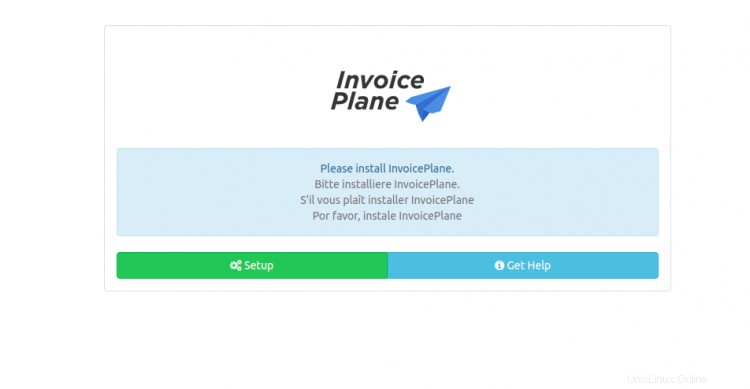
Haga clic en Configuración botón. Debería ver la página de selección de idioma:
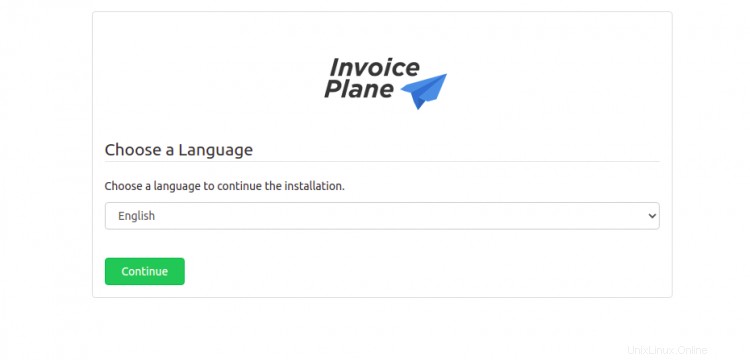
Seleccione su idioma y haga clic en Continuar botón. Debería ver la página de requisitos previos:

Haga clic en Continuar botón. Debería ver la siguiente página:
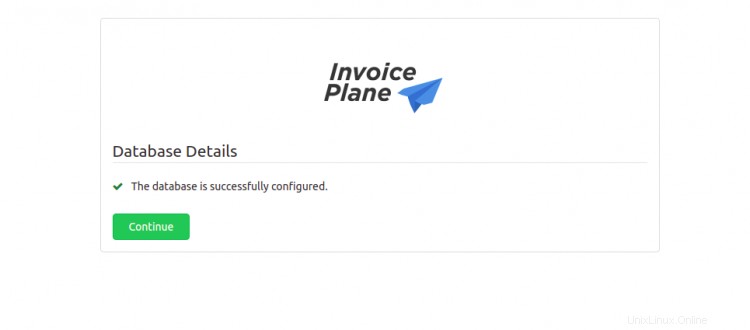
Haga clic en Continuar botón. Debería ver la siguiente página:
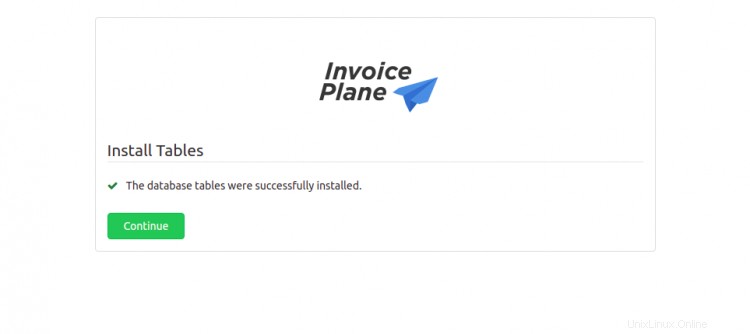
Haga clic en Continuar botón. Debería ver la siguiente página:
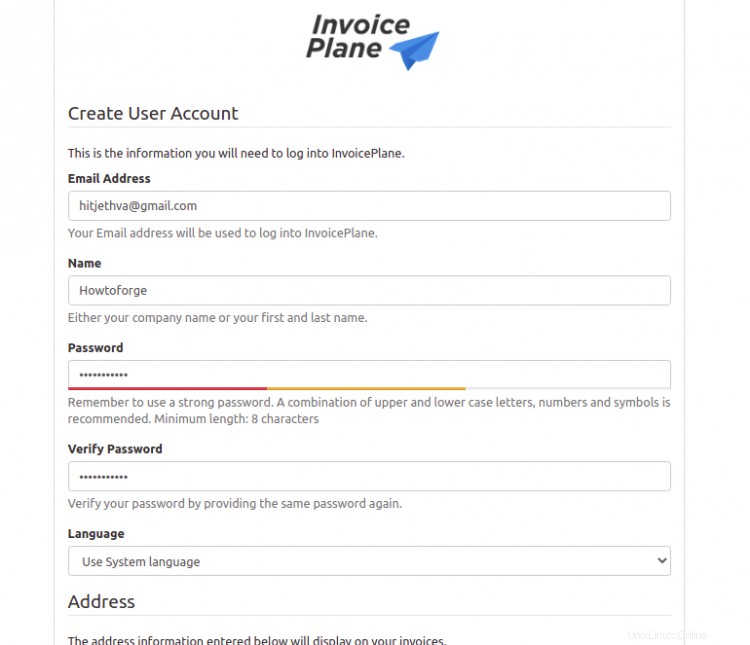
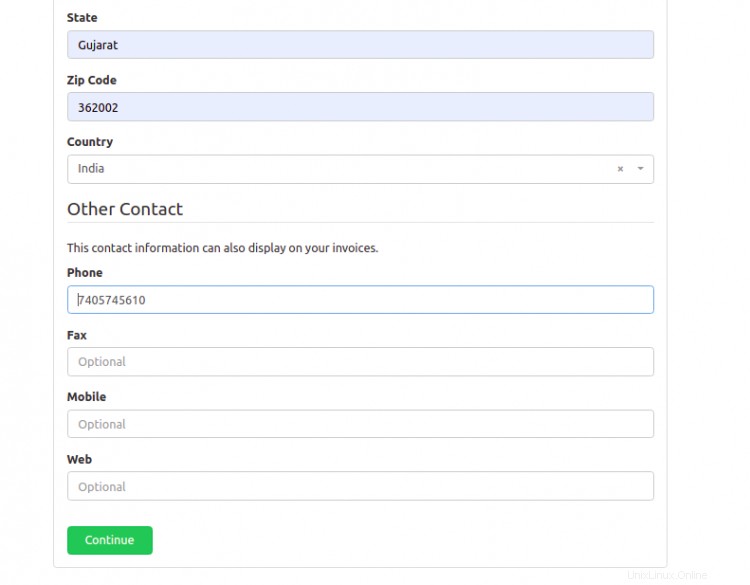
Proporcione la información de su cuenta de usuario administrador, dirección y haga clic en Continuar botón. Una vez que se haya instalado InvoicePlane, debería ver la siguiente página:
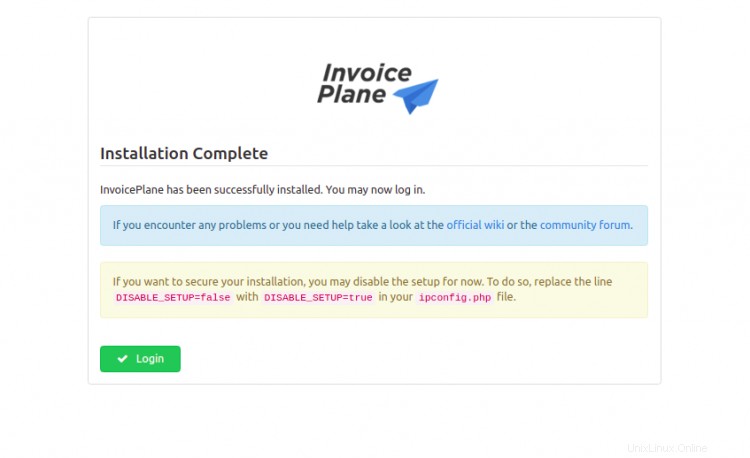
Haga clic en Iniciar sesión botón. Debería ver la siguiente página:

Proporcione su nombre de usuario y contraseña de administrador y luego haga clic en Iniciar sesión botón. Debería ver el panel de InvoicePlane en la siguiente página:
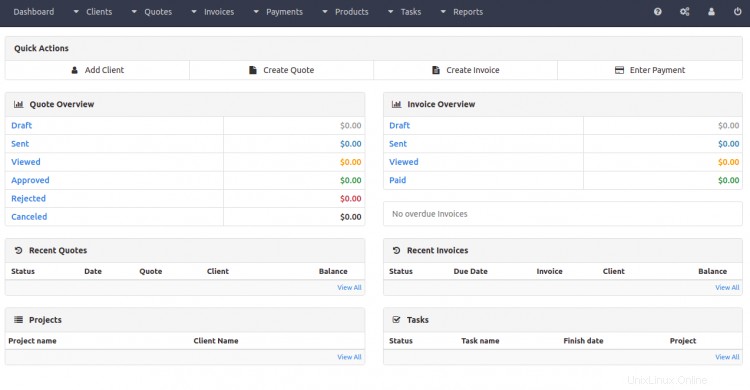
Asegure InvoicePlane con Let's Encrypt SSL
Siempre es una buena idea proteger su sitio web con Let's Encrypt SSL. Deberá instalar el cliente Certbot para instalar y administrar SSL. Puede instalarlo con el siguiente comando:
apt-get install python3-certbot-apache -y
Una vez que Certbot esté instalado, ejecute el siguiente comando para proteger su sitio web con Let's Encrypt SSL:
certbot --apache -d invoice.example.com
Se le pedirá que proporcione su correo electrónico y acepte el término del servicio como se muestra a continuación:
Saving debug log to /var/log/letsencrypt/letsencrypt.log Plugins selected: Authenticator standalone, Installer None Enter email address (used for urgent renewal and security notices) (Enter 'c' to cancel): [email protected] - - - - - - - - - - - - - - - - - - - - - - - - - - - - - - - - - - - - - - - - Please read the Terms of Service at https://letsencrypt.org/documents/LE-SA-v1.2-November-15-2017.pdf. You must agree in order to register with the ACME server at https://acme-v02.api.letsencrypt.org/directory - - - - - - - - - - - - - - - - - - - - - - - - - - - - - - - - - - - - - - - - (A)gree/(C)ancel: A - - - - - - - - - - - - - - - - - - - - - - - - - - - - - - - - - - - - - - - - Would you be willing to share your email address with the Electronic Frontier Foundation, a founding partner of the Let's Encrypt project and the non-profit organization that develops Certbot? We'd like to send you email about our work encrypting the web, EFF news, campaigns, and ways to support digital freedom. - - - - - - - - - - - - - - - - - - - - - - - - - - - - - - - - - - - - - - - - (Y)es/(N)o: Y Plugins selected: Authenticator apache, Installer apache Obtaining a new certificate Performing the following challenges: http-01 challenge for invoice.example.com Enabled Apache rewrite module Waiting for verification... Cleaning up challenges Created an SSL vhost at /etc/apache2/sites-available/invoice-le-ssl.conf Enabled Apache socache_shmcb module Enabled Apache ssl module Deploying Certificate to VirtualHost /etc/apache2/sites-available/invoice-le-ssl.conf Enabling available site: /etc/apache2/sites-available/invoice-le-ssl.conf
A continuación, seleccione si desea redirigir o no el tráfico HTTP a HTTPS como se muestra a continuación:
Please choose whether or not to redirect HTTP traffic to HTTPS, removing HTTP access. - - - - - - - - - - - - - - - - - - - - - - - - - - - - - - - - - - - - - - - - 1: No redirect - Make no further changes to the webserver configuration. 2: Redirect - Make all requests redirect to secure HTTPS access. Choose this for new sites, or if you're confident your site works on HTTPS. You can undo this change by editing your web server's configuration. - - - - - - - - - - - - - - - - - - - - - - - - - - - - - - - - - - - - - - - - Select the appropriate number [1-2] then [enter] (press 'c' to cancel): 2
Escriba 2 y presione Entrar para instalar Let's Encrypt SSL para su sitio web:
Enabled Apache rewrite module Redirecting vhost in /etc/apache2/sites-enabled/invoice.conf to ssl vhost in /etc/apache2/sites-available/invoice-le-ssl.conf - - - - - - - - - - - - - - - - - - - - - - - - - - - - - - - - - - - - - - - - Congratulations! You have successfully enabled https://invoice.example.com You should test your configuration at: https://www.ssllabs.com/ssltest/analyze.html?d=invoice.example.com - - - - - - - - - - - - - - - - - - - - - - - - - - - - - - - - - - - - - - - - IMPORTANT NOTES: - Congratulations! Your certificate and chain have been saved at: /etc/letsencrypt/live/invoice.example.com/fullchain.pem Your key file has been saved at: /etc/letsencrypt/live/invoice.example.com/privkey.pem Your cert will expire on 2022-04-23. To obtain a new or tweaked version of this certificate in the future, simply run certbot again with the "certonly" option. To non-interactively renew *all* of your certificates, run "certbot renew" - If you like Certbot, please consider supporting our work by: Donating to ISRG / Let's Encrypt: https://letsencrypt.org/donate Donating to EFF: https://eff.org/donate-le
Conclusión
¡Felicidades! ha instalado exitosamente InvoicePlane con Apache y Let's Encrypt SSL en Debian 11. Ahora puede implementar InvoicePlane en su empresa y comenzar a administrar sus pagos y facturas desde el navegador web.